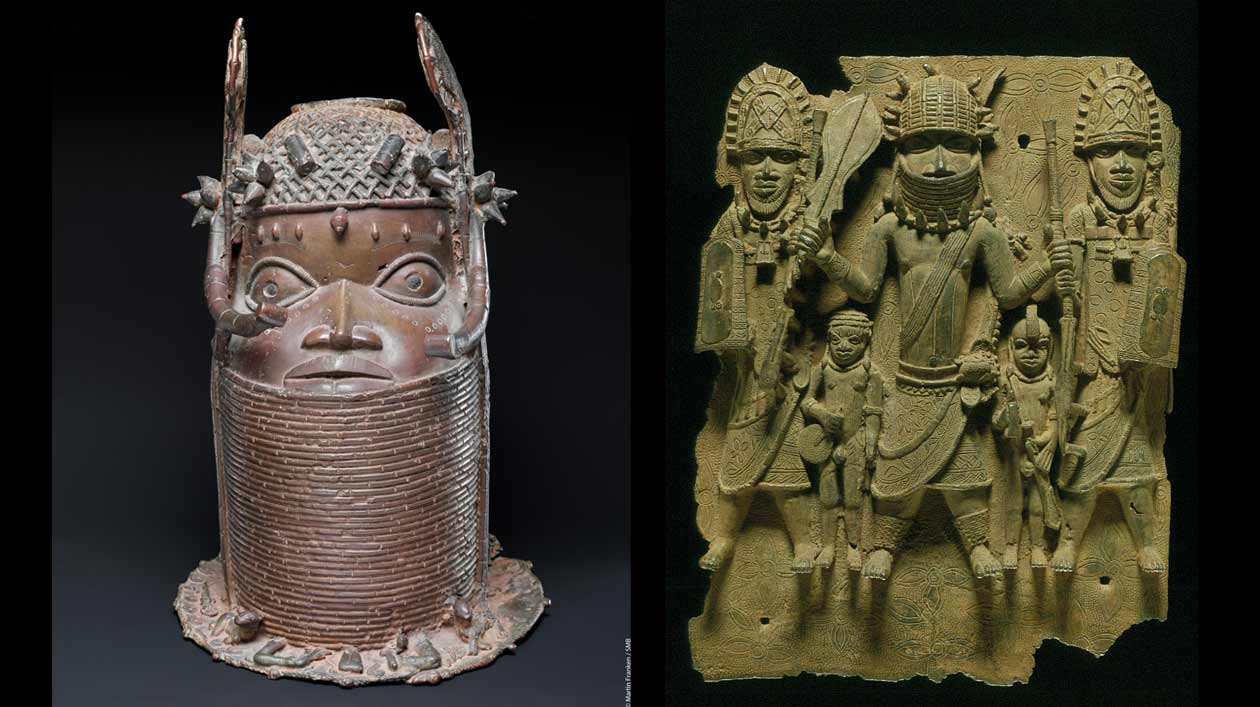First German Return of "Benin Bronzes"
News from 07/01/2022
Commemorative head and relief plaque from the Ethnological Museum of the National Museums in Berlin

The collections of the Ethnological Museum of the National Museums in Berlin currently include more than 500 objects from the former Kingdom of Benin, which forms part of present-day Nigeria.
In 1897, British troops conquered the Kingdom of Benin, looted the royal palace and exiled Oba Ovonramwen, the last independent king, to Calabar. Thousands of objects were shipped to London as war booty and sold there. Hundreds more of the looted objects initially remained in colonial Nigeria, but subsequently found their way to European and North American museums through networks of European and African businessmen and traders.
Amongst many others, the Berlin museum benefited from the colonial system and its "acquisitions" enforced by violence. Since 2010, it has been a member of the Benin Dialogue Group, in which European Museumsdiscuss the future of Benin objects in their collections with Nigerian partners. In March 2021, negotiations on returns to Nigeria began at government level, which have now been brought to a conclusion with the signing of a Bilateral Political Declaration. A few days ago, the Board of Trustees of the SPK, chaired by Minister of State for Culture Claudia Roth, authorized SPK to conclude an agreement on the transfer of ownership of the objects from the Ethnological Museum and on loans with the responsible authorities in Nigeria in the second half of 2022.
Returns in July 2022
As a prelude to the process of restitution that will now begin and on behalf of all the other German museums involved in the process, two objects from the Ethnological Museum's collection were handed over to Nigeria on 1 July 2022 as part of an initial agreement: a memorial head of a king and a relief plaque with a king (Oba) and four attendants. A further agreement on the other "Benin bronzes" in the collection of the Ethnological Museum will follow in the course of the year in accordance with the Foundation Council's decision.
Commemorative head of a king
Plastic; brass, dimensions: 52 x 32.5 x 35.5 cm, diameter: 34 cm, weight: 35.1 kg, 18th century (III C 8196).
The imperishable materials brass and ivory were reserved for the oba (king). Altar ensembles with memorial heads of deceased kings and ivory tusks (oliphants) carved with figures and emblematic representations were at the centre of the annual cycle for the cult of royal ancestors and the renewal of kingship.
Provenance: Commissioned by the Igun Eronmwon or Guild of Brass Founders in the Kingdom of Benin for a royal memorial altar; passed on by inheritance to Oba Ovonramwen (c. 1857-1914; r. 1888-97). Royal Palace, Benin City; looted in connection with the British conquest of Benin, 1897; in unknown possession after the conquest of the Kingdom of Benin; came into the possession of Consul Eduard Schmidt, employee of the Woermann line, between 1897 and 1898 in the area of what later became colonial Nigeria; sold to the Königliches Museum für Völkerkunde in Berlin, 1898.
King with four attendants
Relief plaque, brass, 50x37 cm, 15.4 kg, 16th century (III C 8208).
This relief plaque shows a king with four attendants. Such relief plaques, made by the lost-wax process, were found on the pillars of the long, quadrangular inner courtyards of the palace in the historical kingdom of Benin (ca. 900 AD until the end of the 19th century). They show repeating motifs of the king, dignitaries, Portuguese, elements of the cosmos or animals.
Provenance: 16th century, commissioned by Oba Esigie (r. 1517-1550) or his son Oba Orhogbua (r. 1550-1570), Royal Palace, Benin City; by inheritance to Oba Ovonramwen (c. 1857-1914; r. 1888-97), Royal Palace, Benin City; looted in connection with the British conquest of Benin, 1897; in unknown possession after the conquest from the Kingdom of Benin; came into the possession of Consul Eduard Schmidt, employee of the Woermann line, between 1897 and 1898 in the area of what later became colonial Nigeria; sold to the Royal Museum of Ethnology in Berlin, 1898.

